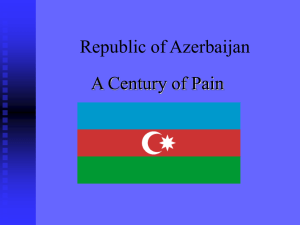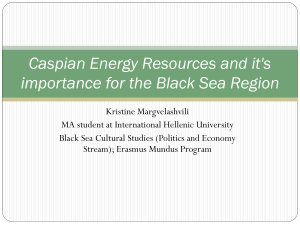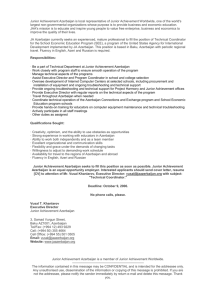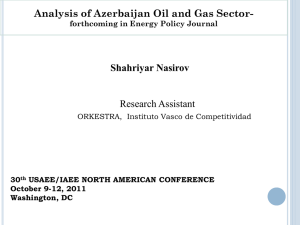Azerbaijan Fuel
advertisement
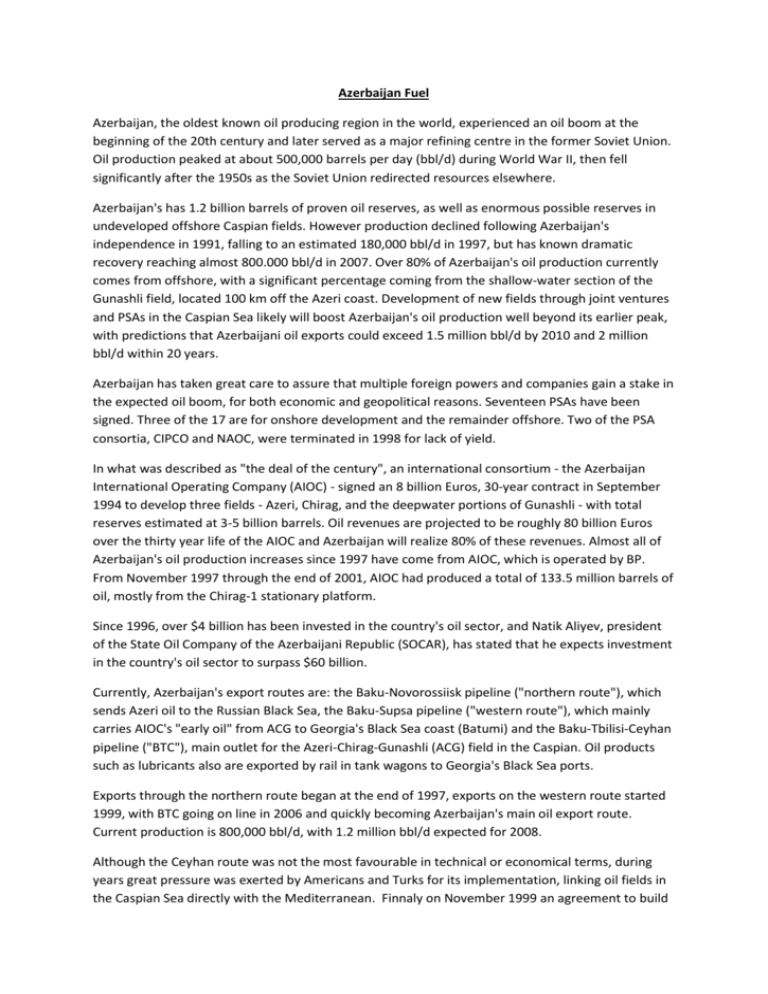
Azerbaijan Fuel Azerbaijan, the oldest known oil producing region in the world, experienced an oil boom at the beginning of the 20th century and later served as a major refining centre in the former Soviet Union. Oil production peaked at about 500,000 barrels per day (bbl/d) during World War II, then fell significantly after the 1950s as the Soviet Union redirected resources elsewhere. Azerbaijan's has 1.2 billion barrels of proven oil reserves, as well as enormous possible reserves in undeveloped offshore Caspian fields. However production declined following Azerbaijan's independence in 1991, falling to an estimated 180,000 bbl/d in 1997, but has known dramatic recovery reaching almost 800.000 bbl/d in 2007. Over 80% of Azerbaijan's oil production currently comes from offshore, with a significant percentage coming from the shallow-water section of the Gunashli field, located 100 km off the Azeri coast. Development of new fields through joint ventures and PSAs in the Caspian Sea likely will boost Azerbaijan's oil production well beyond its earlier peak, with predictions that Azerbaijani oil exports could exceed 1.5 million bbl/d by 2010 and 2 million bbl/d within 20 years. Azerbaijan has taken great care to assure that multiple foreign powers and companies gain a stake in the expected oil boom, for both economic and geopolitical reasons. Seventeen PSAs have been signed. Three of the 17 are for onshore development and the remainder offshore. Two of the PSA consortia, CIPCO and NAOC, were terminated in 1998 for lack of yield. In what was described as "the deal of the century", an international consortium - the Azerbaijan International Operating Company (AIOC) - signed an 8 billion Euros, 30-year contract in September 1994 to develop three fields - Azeri, Chirag, and the deepwater portions of Gunashli - with total reserves estimated at 3-5 billion barrels. Oil revenues are projected to be roughly 80 billion Euros over the thirty year life of the AIOC and Azerbaijan will realize 80% of these revenues. Almost all of Azerbaijan's oil production increases since 1997 have come from AIOC, which is operated by BP. From November 1997 through the end of 2001, AIOC had produced a total of 133.5 million barrels of oil, mostly from the Chirag-1 stationary platform. Since 1996, over $4 billion has been invested in the country's oil sector, and Natik Aliyev, president of the State Oil Company of the Azerbaijani Republic (SOCAR), has stated that he expects investment in the country's oil sector to surpass $60 billion. Currently, Azerbaijan's export routes are: the Baku-Novorossiisk pipeline ("northern route"), which sends Azeri oil to the Russian Black Sea, the Baku-Supsa pipeline ("western route"), which mainly carries AIOC's "early oil" from ACG to Georgia's Black Sea coast (Batumi) and the Baku-Tbilisi-Ceyhan pipeline ("BTC"), main outlet for the Azeri-Chirag-Gunashli (ACG) field in the Caspian. Oil products such as lubricants also are exported by rail in tank wagons to Georgia's Black Sea ports. Exports through the northern route began at the end of 1997, exports on the western route started 1999, with BTC going on line in 2006 and quickly becoming Azerbaijan's main oil export route. Current production is 800,000 bbl/d, with 1.2 million bbl/d expected for 2008. Although the Ceyhan route was not the most favourable in technical or economical terms, during years great pressure was exerted by Americans and Turks for its implementation, linking oil fields in the Caspian Sea directly with the Mediterranean. Finnaly on November 1999 an agreement to build the Ceyhan pipeline was signed at the Organization for Security and Co-operation in Europe summit in Istanbul. The agreement included two pipelines ending on the Turkish coast - a seventeen hundred kilometre oil pipeline from Azerbaijan, and a gas pipeline from Turkmenistan. Construction work of the oil pipeline was completed in the Spring of 2005. Now that the BTC pipeline is built, it provides the Turks with lucrative transit fees and aid the Americans in their bid to prevent Iran from becoming a major export route for Caspian oil, as well as limiting the Russian influence, and therefore the European influence, in the area. A regional pipeline and transit system centered on Azerbaijan is beginning to emerge. Oil is being shipped across the Caspian from Kazakhstan and Turkmenistan to the port of Baku for further transshipment by rail and pipeline westward to the Black Sea. Shipping volumes have risen from 2,000 bbl/d in 1996 to 20,000 bbl/d in 1997 and an estimated 60,000 bbl/d in 1998. Shipping company Caspian Transco has been working with the Azeri government to overhaul and expand the oil terminal facilities at Dyubendi, 50 kms northeast of Baku, to allow for further increases. Since 1999 the EU made loans to Azerbaijan of about 25 million Euros under the TRACECA program to rehabilitate and upgrade the seaport near Baku to allow up to 500,000 bbl/d of oil shipments from the eastern Caspian. As Caspian production increases, trans-Caspian pipelines could carry increasing volumes of oil and gas from Kazakhstan and Turkmenistan. The cross-Caspian pipelines could connect with other export pipelines from Azerbaijan, such as the proposed MEP and the early oil routes. In addition, Iran has proposed a pipeline that would transport oil from Baku via a proposed 300 km pipeline to Tabriz in northwest Iran, where it would also connect with the existing Iranian pipeline network and refineries Azeri crude oil is refined domestically at two refineries: the Azerineftyag (Baku) refinery, with a capacity of 230,000 bbl/d, and the Azerneftyanajag (New Baku) refinery, which has a capacity of 212,000 bbl/d. With domestic production topping out at 311,200 bbl/d in 2001 (and half of that exported as crude oil), Azerbaijan's refineries have been running well below capacity, with overall refinery utilization rates as low as 40%. Heating oil accounts for approximately 50% of output at Azeri refineries, followed by diesel fuel (28%), gasoline (10%), motor oil (7%), kerosene (3%), and other products (2%). Both of the country's refineries are in need of modernization, which the Azeri government estimates will cost between $600 million and $700 million. Modernization of the two refineries will enable Azerbaijan to process imported crude oil, thereby freeing up domestic oil for export via the Baku-Ceyhan pipeline. One potential complication in Azerbaijan's plans for developing its Caspian Sea resources is uncertainty over the legal status of the Caspian Sea - specifically the territorial rights of nations bordering its shores (Russia, Kazakhstan, Turkmenistan, Iran, and Azerbaijan). Azerbaijan has advocated the establishment of maritime boundaries into national sectors based on the equidistant division of the sea. Azerbaijan recently entered into a dispute with Turkmenistan over a field called Kyapaz by Azerbaijan and Serdar by Turkmenistan, which included it as part of its Block 30 licensing. In addition, Azerbaijan's Foreign Ministry has objected to the Iranian decision to award Royal Dutch/Shell and Lasmo a license to conduct seismic surveys in a region that Azerbaijan considers to fall in Azeri territory, and has announced that it will call a tender for the D-43, D-44, and D-74 fields which are located in the same region. Although lately positive sings have been appearing, to date no final resolution of Caspian Sea legal issues has been achieved SOCAR "The State Oil Company of Azerbaijan Republic " The State Oil Company of the Azerbaijan Republic (SOCAR) is involved in exploring oil and gas fields, producing, processing, and transporting oil, gas, and gas condensate, marketing petroleum and petrochemical products in domestic and international markets, and supplying natural gas to industry and the public in Azerbaijan. Three production divisions, two oil refineries and one gas processing plant, an oil tanker fleet, a deep water platform fabrication yard, two trusts, one institution, and 22 subdivisions are operating as corporate entities under SOCAR. Joint ventures (including ventures in Georgia and Turkey), consortia, and operating companies established with SOCAR's participation, are doing business in different parts of the petroleum industry. SOCAR has representative offices in Georgia, Turkey, Romania, Austria, Switzerland, Kazakhstan, Great Britain, Iran, Germany and Ukraine and trading companies in Switzerland, Singapore, Vietnam, Nigeria, and other countries. Oil and Gas Research and Design Institute Summary of Role and Services SOCAR's Oil and Gas Research and Design Institute is involved in geological and geophysical surveys of prospects and oil and gas fields, exploration, the preparation of prospects for development, oil and gas field development, well drilling, completion, and operation, petrochemical and petroleum processing engineering, petroleum industry economic and management studies, the preparation of short-term reservoir engineering strategies, environmental protection, the processing, storage, and transportation of petroleum products, and the drafting and official registration of pertinent regulations. The Institute is extensively involved in field development and the design of oil and gas processing facilities. More than 80 laboratories and departments engaged in research, design, and engineering operate under the Institute. The Institute's scientific potential is evidenced by its staff of 22 Doctors of Science and 188 Candidates of Science, and most of the Institute's world-class research has been confirmed by inventor's certificates. The Institute has more than 1200 inventions to its credit. The Institute's high scientific prowess and wealth of expertise gained over the course of many years have allowed the organization to resolve challenging scientific and engineering problems in the comprehensive development of geologically complex oil fields. The Oil and Gas Research and Design Institute fills orders from SOCAR’s divisions and does contract work for third parties.

